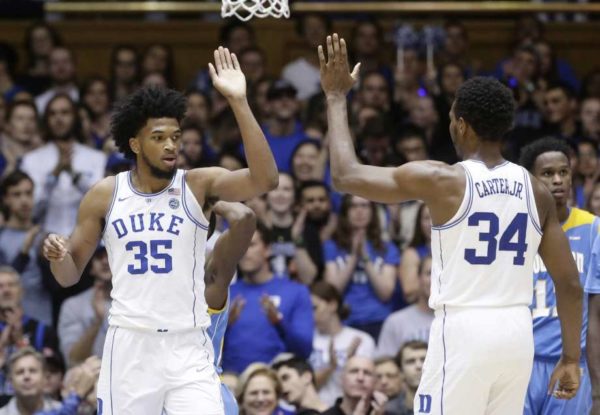On a Different Kind of Duke Team So Far…
Posted by Brad Jenkins (@bradjenk) on November 22nd, 2017Most of the Duke teams of recent vintage have been known for talented perimeter scorers and three-point shooters. With the exception of the 2015 National Championship squad anchored by freshman superstar Jahlil Okafor, the Blue Devils have often been relatively weak defensively and particularly soft on the interior, resulting in several early exits from the NCAA Tournament (e.g., South Carolina, Oregon, Mercer). So far this year, things are looking different in Durham. The strength of Mike Krzyzewski’s current #1 team appears to be in its overall balance — great options in the post to go along with a solid backcourt and a somewhat improved defense. However, there are still a few areas of concern that Coach K will need to address in order to feel good about making a run at his sixth national title next March.

Star big men Marvin Bagley and Wendell Carter have given Duke a different look this year.
(Gerry Broome/AP Photo)
Over the past two decades, Krzyzewski has mostly utilized a four-around-one offensive scheme that was heavy on floor spacing and light on post touches. However, with the frontcourt size and talent at his disposal this year, he has adopted more of an inside-out approach. In most of the Blue Devils’ half-court sets, they first look to feed freshmen Marvin Bagley and Wendell Carter on the blocks. Both Bagley (19.2 PPG, 9.0 RPG, 62.1% FG) and Carter (13.2 PPG, 9.0 RPG, 61.5% FG) are off to fast starts this season, and Bagley’s numbers would be even better if he hadn’t left last week’s game versus Michigan State with an eye injury. In that 88-81 win over the Spartans, Carter came up huge in Bagley’s absence, tallying second half marks of 10 points and 10 rebounds. Even more talent exists on the perimeter, and perhaps for the first time since the championship season, the pieces seem to fit well together. Grayson Allen (18.4 PPG, 50.0% 3FG) and Gary Trent, Jr. (11.6 PPG, 37.9% 3FG) have been very effective on the wings, and freshman Trevon Duval (13.6 PPG, 38 assists/7 turnovers) is running the point guard position like a seasoned veteran. But not everything with the new-look Blue Devils is rosy — after five games, Duke is shooting a measly 61.7 percent from the foul line, and Bagley (50.0%) in particular is leaving too many points at the charity stripe.
Duke has shown flashes of being an improved defensive team compared with the last two seasons, but it’s too early to suggest that the Blue Devils will field a championship level defense. There is better rim protection potential on the floor this year with Carter (14 blocks) and Bagley up front, as the duo are allowing opponents to convert just 43.0 percent of their two-point attempts. However, the only top tier team they’ve encountered so far is Michigan State, which connected on a robust 61.1 percent of its attempts from two-point range. On the perimeter, Duval (12 steals) has been effective in harassing opposing guards, but the wing shooters are finding more open looks this season. Part of this may be explained by Krzyzewski opting to play more zone, but teams are taking more threes (40.1% 3PA) against Duke this year and converting those attempts at a decent clip (34.9% 3FG). If those numbers stand, they would be the highest three-point attempt and conversion rates allowed by Duke in the 17-year KenPom era. Krzyzewski played zone for all 40 minutes against the Spartans, even if that wasn’t his original intent. Given that Duke has a long and athletic front line, zone may turn out to be the Krzyzewski’s defense of choice this year.
Off the bench, 6’10” sophomore Javin Delaurier has proven to be a defensive menace with eight blocks and seven steals to date, but there has not been a lot of other production from Duke’s reserves. Krzyzewski’s top six players may be as good as any group in college basketball, but with such a huge drop in talent beyond that sextet, injuries and foul difficulties will always be a concern. On a positive note and unlike many recent Duke teams, these Blue Devils can use rebounding (45.8% OReb rate) and defense to overcome bad shooting nights against good teams. Duke triumphed against Michigan State despite posting an effective field goal percentage of only 45.2 percent for the game. In the prior two seasons, as a contrast, the Blue Devils went just 1-11 against KenPom top-100 teams in games in which they failed to reach 50 percent in that shooting metric.










































